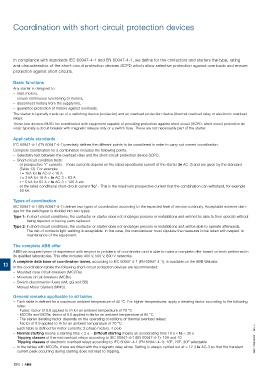Page 826 - Motor_protection_and_control_Manual_motor_starters_ contactors
P. 826
Coordination with short-circuit protection devices
In compliance with standards IEC 60947-4-1 and EN 60947-4-1, we define for the contactors and starters the type, rating
and characteristics of the short-circuit protection devices SCPD which allow selective protection against overloads and ensure
protection against short circuits.
Basic functions
Any starter is designed to:
– start motors,
– ensure continuous functioning of motors,
– disconnect motors from the supply line,
– guarantee protection of motors against overloads.
The starter is typically made up of a switching device (contactor) and an overload protection device (thermal overload relay or electronic overload
relay).
These two devices MUST be coordinated with equipment capable of providing protection against short circuit (SCPD: short circuit protective de-
vice): typically a circuit breaker with magnetic release only or a switch fuse. These are not necessarily part of the starter.
Applicable standards
IEC 60947-4-1 (EN 60947-4-1) precisely defines the different points to be considered in order to carry out correct coordination.
Complete coordination for a combination includes the following points:
– Selectivity test between the overload relay and the short-circuit protection device SCPD.
– Short-circuit condition tests:
- at prospective "r" currents - These currents depend on the rated operational current of the starter (Ie AC-3) and are given by the standard
(Table 13). For example:
r = 1kA for Ie AC-3 < 16 A
r = 3 kA for 16 A < Ie AC-3 < 63 A
r = 5 kA for 63 A < Ie AC-3 < 125 A etc.
- at the rated conditional short-circuit current "Iq" - This is the maximum prospective current that the combination can withstand, for example
50 kA.
Types of coordination
IEC 60947-4-1 (EN 60947-4-1) defines two types of coordination according to the expected level of service continuity. Acceptable extreme dam-
age for the switchgear is divided into two types.
Type 1: In short-circuit conditions, the contactor or starter does not endanger persons or installations and will not be able to then operate without
being repaired or having parts replaced.
Type 2: In short-circuit conditions, the contactor or starter does not endanger persons or installations and will be able to operate afterwards.
The risk of contacts light welding is acceptable. In this case, the manufacturer must stipulate the measures to be taken with respect to
maintenance of the equipment.
The complete ABB offer
ABB has acquired years of experience with respect to problems of coordination and is able to make a complete offer based on tests performed in
its qualified laboratories. This offer includes 400 V, 500 V, 690 V networks.
A complete data base of coordination tables, according to IEC 60947-4-1 (EN 60947-4-1), is available on the ABB Website.
13 In the coordination tables the following short-circuit protection devices are recommended:
– Moulded case circuit-breakers (MCCBs)
– Miniature circuit-breakers (MCBs)
– Switch-disconnector-fuses (aM, gG and BS)
– Manual Motor Starters (MMS).
General remarks applicable to all tables
– Each table is defined for a maximum ambient temperature of 40 °C. For higher temperatures, apply a derating factor according to the following
rules:
- Fuses: factor of 0.8 applied to In for an ambient temperature of 70 °C
- MCCBs and MCBs: factor of 0.8 applied to In for an ambient temperature of 60 °C
- The starter derating factor depends on the operating conditions of thermal overload relays:
Factor of 0.9 applied to In for an ambient temperature of 70 °C.
– Each table is defined for motor currents: 3-phase motors, 4-pole
– Normal starting means a starting time < 2 s. - Difficult starting means an accelerating time 10 s < ts < 30 s
Tripping classes of thermal overload relays according to IEC 60947-4-1 (EN 60947-4-1): 10A and 10
Tripping classes of electronic overload relays according to IEC 60947-4-1 (EN 60947-4-1): 10E, 20E, 30E selectable 1SBC101590S0201 - Rev. A
– In the tables with MCCBs, these are fitted with the magnetic relay alone. Setting is always carried out at > 12.3 Ie AC-3 so that the transient
current peak occurring during starting does not lead to tripping.
13/8 | ABB

